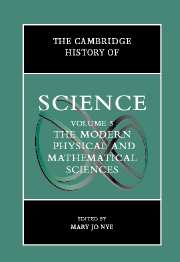Book contents
- Frontmatter
- Introduction: The Modern Physical and Mathematical Sciences
- Part I The Public Cultures of the Physical Sciences After 1800
- Part II Discipline Building in the Sciences: Places, Instruments, Communication
- Part III Chemistry and Physics: Problems Through the Early 1900s
- 11 The Physical Sciences in the Life Sciences
- 12 Chemical Atomism and Chemical Classification
- 13 The Theory of Chemical Structure and its Applications
- 14 Theories and Experiments on Radiation from Thomas Young to X Rays
- 15 Force, Energy, and Thermodynamics
- 16 Electrical Therory and Practice in the Nineteenth Century
- Part IV Atomic and Molecular Sciences in the Twentieth Century
- Part V Mathematics, Astronomy, and Cosmology Since the Eighteenth Century
- Part VI Problems and Promises at the End of the Twentieth Century
- Index
- References
14 - Theories and Experiments on Radiation from Thomas Young to X Rays
from Part III - Chemistry and Physics: Problems Through the Early 1900s
Published online by Cambridge University Press: 28 March 2008
- Frontmatter
- Introduction: The Modern Physical and Mathematical Sciences
- Part I The Public Cultures of the Physical Sciences After 1800
- Part II Discipline Building in the Sciences: Places, Instruments, Communication
- Part III Chemistry and Physics: Problems Through the Early 1900s
- 11 The Physical Sciences in the Life Sciences
- 12 Chemical Atomism and Chemical Classification
- 13 The Theory of Chemical Structure and its Applications
- 14 Theories and Experiments on Radiation from Thomas Young to X Rays
- 15 Force, Energy, and Thermodynamics
- 16 Electrical Therory and Practice in the Nineteenth Century
- Part IV Atomic and Molecular Sciences in the Twentieth Century
- Part V Mathematics, Astronomy, and Cosmology Since the Eighteenth Century
- Part VI Problems and Promises at the End of the Twentieth Century
- Index
- References
Summary
Four different, but related, topics will be examined in this chapter: first, the debate between the emission theory and the undulatory theory of light; second, the discovery of new kinds of radiation, such as heat (infrared) and chemical (ultraviolet) rays at the beginning of the nineteenth century, and the gradual emergence of the consensus that heat, light, and chemical rays constituted the same continuous spectrum; third, the development of spectroscopy and spectrum analysis; and finally, the emergence of the electromagnetic theory of light and the subsequent laboratory creation of electromagnetic waves, as well as the discovery of x rays at the end of the nineteenth century.
The account given here is based on current scholarship in the history of nineteenth-century physics and, in particular, optics and radiation. However, as the current status of historical research on each of these topics is not homogeneous, different historical and historiographical points will be stressed for each topic. The first subject will stress historiographical issues in interpreting the optical revolution, with reference to Thomas Kuhn’s scheme of the scientific revolution. The second and third subjects, which have not yet been thoroughly examined by historians, will stress the interplay among theory, experiment, and instruments in the discovery of new rays and the formation of the idea of the continuous spectrum. The fourth subject, Maxwell’s electromagnetic theory of light, is rather well known, but the account here concentrates on the transformation of a theoretical concept into a laboratory effect, and then on the transformation of the laboratory effect into a technological artifact.
- Type
- Chapter
- Information
- The Cambridge History of Science , pp. 272 - 288Publisher: Cambridge University PressPrint publication year: 2002



